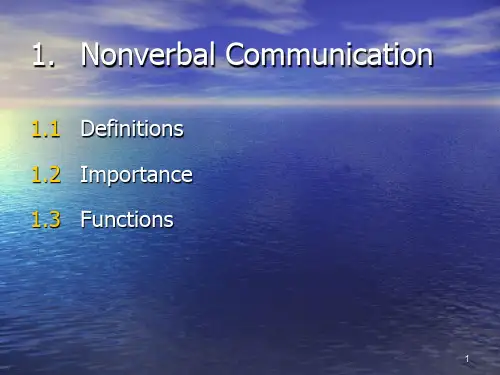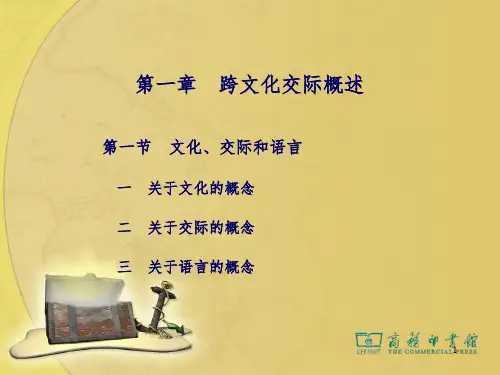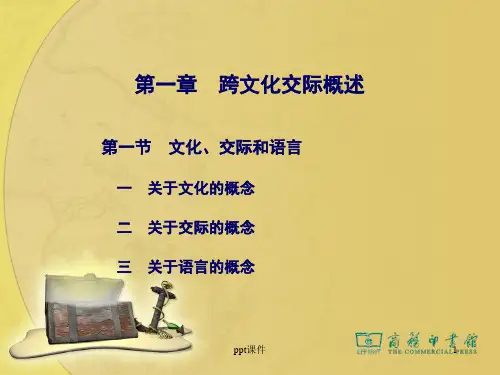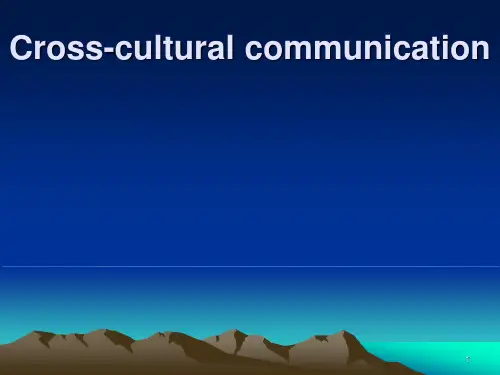跨文化交际 课件
- 格式:doc
- 大小:303.50 KB
- 文档页数:22











Chapter Two Cultural Differences andCommunication--- A theoretical introductionPeople from different cultures tend to communicate differently. Culture, in general, will exert great influence on the process of sending and interpreting messages between communicators from distinct cultural backgrounds. In this chapter, we will look into some theories on cultural differences and similarities which influence the process of intercultural communication. With these theories, you may have a frame of referrence when you communicate with people from other cultures and compare them with your own culture. You may have some ideas on questions such as from which aspects can cultures differ? And then you can create a profile of the culture from which the person you are communicating with comes. This can help you make reasonable predictions on people’s behavior in communication and avoid making misunderstandings. We will start from Kluckhohn and Strodtbeck’s value orientations.1. Kluckhohn and Strodtbeck’s value orientationsValue orientations are “complex but definitely patterned principles which give order and direction to the ever-flowing stream of human acts and thoughts as these relate to the solution of common human problems” (Kluckhohn & strodtbeck, 1961). The theory of value orientations is based on the following assumptions:(1)people in all cultures must find solutions to a limited number of common human problems;Kluckhohn and Strodtbeck (1961) describe five problems for which all cultures must find solutions. (1)What is the nature of human beings (human nature orientation)?(2) What is the relationship of people to nature(person-nature orientation)? (3) What is the orientation of humans to time (time orientation)? (4) What is the human orientation to activity(activity orientation)? (5) What is the relationship of one person to another (relational orientation)? As indicated above, every culture must find a solution to each of these problems. The solutions available, however, are limited for each of the problems.(2)the range of alternative solutions to a culture’s problems is limited;Because cultures must select their solutions from a range of available alternatives. Later when we elaborate on the five problems, you will see the answers to these problems are limited.(3)while one solution tends to be preferred by members of any given culture, all potential solutions are present in every culture. That means within any culture, a preferred set of solution will be chosen by most people. However not all people from a culture will make exactly the same set of choices, and in fact, some people from each culture will select other alternatives.(4)Over time, the preferred solutions shape the culture’s basic assumptions about beliefs, values, norms, and social practices---the cultural patterns.This means people tend to regularly solve one type of problems in the same way. Then little by little, the same behaviors to solve particular problems and the reasons or ideas underlying these behaviors become the preferred beliefs, values, norms and social practices. Thus the cultural patterns formed.Belief: A belief is an idea that people assume to be true about the world. It is about what is and what is not logical and correctValue: values involve what a culture regards as good or bad, right or wrong, fair or unfair, just or unjust, beautiful or ugly, clean or dirty, valuable or worthless, appropriate or inappropriate, and kind or cruel.Norms are the socially shared expectations of appropriate behaviors.Social practices are the outward manifestations of beliefs, values, and norms.Human Nature OrientationThe human nature orientation deals with the innate character of human nature. The potential solutions to this problem appear relatively obvious: Humans can be seen as innately good, innately evil, or a mixture of good and evil. It is not quite that simple, however. Humans can be viewed not only as either good or evil but also as either able to change (mutable) or not able to change (immutable). In addition, we must recognize that viewing human nature as a mixture of good and evil is not the same as viewing human nature as neutral. If we combine these various aspects, we find that there are six potential solutions to this problem: (1) humans are evil but mutable; (2) humans are evil and immutable; (3) humans are neutral with respect to good and evil; (4) humans are a mixture of good and evil; (5) humans are good but mutable; (6) humans are good and immutable.When this orientation is applied to the United States, it is not always easy to decide which solution predominates. People in the United States inherited a view of human nature as evil but mutable from their Puritan predecessors. Puritans were convinced that human beings were predestined by God before they were born. Some were God’s chosen people while others were predestined to be damned to hell. In order to be God’s select, people must work hard, spend little and invest for more business to become very successful in his calling. In this view, discipline and self-control are seen as necessary if humans are to change. Some subcultures within the United States definitely adopt this solution, but predominant view in the middle-class subculture of the US is probably the view of human nature as a mixture of good and evil.Person-Nature OrientationThree potential types of relations exist between humans and nature: mastery over nature; harmony with nature; and subjugation (征服,镇压) to nature. These solutions are relatively straightforward and are illustrated best by example.In industrialized societies like the United States, the mastery-over-nature view tends to predominate. This orientation involves the view that all natural forces can and should be overcome and/or put to use by humans; examples are damming rivers, moving mountains, and controlling illness through medicine. Excellent examples ofthis cultural belief found in news reports whenever a natural disaster occurs in the United States. For instance, when a large earthquake hit the Los Angeles area in January 1994, and many people were killed when an apartment building and freeways collapsed, political leaders from California were outraged that the state’s buildings and bridges could be unsafe. The assumption in these pronouncements was that the consequences of natural forces such as earthquakes could have been prevented simply by using better technology and by reinforcing the structures to withstand the forces of nature.The harmony-with-nature orientation draws no distinctions between human life, nature, and the supernatural---any one is just an extension of another. The Cheyenne Indians of North America, for example, see themselves as living in harmony with nature. In their view, “human aspirations are realized not so much through the appeasement (平息,缓和) of whimsical(难以预料的,古怪的) spirit beings and gods as through action that fits the conditions of environmental organization and functioning”. This orientation also predominates in other Native American groups, such as the Navajo, as well as in many Asian cultures, including those of China and Japan.The final solution to this problem, subjugation (屈服) to nature (people have little power to control circumstances that influence their lives), predominates in cultures like those of the Spanish Americans of the southwestern United States, according to Kluckhohn and Strodtbeck. They cite as an example shepherds who believe there is nothing that can be done to control nature if it threatens---neither land nor flock can be protected from storms.Time OrientationThe temporal focus of human life can be directed on the past, the present, or the future. Some cultures choose to describe the future as most important, others emphasize the present, and still others emphasize the past.The past orientation predominates in cultures placing a high value on tradition, worshipping ancestors or emphasizing strong family ties. Also included here are cultures where there is some degree of traditionalism and aristocracy (e.g., England). In Japanese and Chinese cultures the anniversary of the death of a loved one is observed, illustrating the value these cultures place on the past.The present orientation predominates where people pay relatively little attention to what has gone on in the past and what might happen in the future. In this orientation, the past is seen as unimportant, and the future is seen as vague and unpredictable. The Navajo Indians of northern Arizona, for example, have this orientation. To them, only the here and now is real; the future and the past have little reality.The future orientation predominates where change is valued highly. In this orientation, the future generally is viewed as “bigger and better”, while being “old-fashioned”(the past) is scorned. Both Kluckhohn and Strodtbeck and Hall see this orientation predominating in the United States.Activity OrientationHuman activity can be handled in three ways: doing, being, and becoming.The predominant orientation in the United States is doing. A doing orientation involves a focus upon those types of activities that have outcomes external to the individual, that can be measured by someone else. Activities must be tangible. People in the US often ask, “What do you do?”when they first meet someone, a common greeting is “Hi! How are you doing?” and Monday morning conversations between coworkers often center on what each person “did” over the weekend. Similarly, young children are asked what they want to do when they grow up. According to this orientation, if you are sitting at your desk thinking, you are not doing anything because your thoughts cannot be externally measured.The being orientation is almost the extreme opposite of the doing orientation. This orientation values inaction and an acceptance of the status quo. African American and Greek cultures are usually regarded as “being”cultures. Another characterization of this orientation is a belief that all events are determined by fate and are therefore inevitable.A “becoming”orientation sees humans as evolving and changing; people with this orientation, including Native Americans and most South Americans, tend to think of ways to change themselves as a means of changing the world. This orientation is concerned with who we are, not what we have accomplished. The focus of human activity is on striving for an integrated whole in the development of the self. The best example of this orientation may be Zen Buddhist monks, who spend their lives in contemplation and meditation to fully develop the self. 了凡四训Relational OrientationThis value orientation is consistent with the broad dimension of cultural variability, individualism-collectivism, but there are sufficient differences that it needs to be discussed here. Kluckhohn and Strodtbeck isolate three potential ways in which humans can define their relationships to other humans: individualism, lineality (嫡系,世袭), and collaterality (伴随,并列). As we might expect, individualism is the predominant orientation in the US. This orientation is characterized by the autonomy of the individual; in other words, individuals are seen as unique, separate entities. In this orientation, individual goals and objectives take priority over group goals and objectives.The lineality orientation, on the other hand, focuses on the group, with group goals taking precedence over individual goals. The crucial issue in the lineality orientation, according to Kluckhohn and Strodtbeck, is the continuity of the group through time. Specific individuals are important only for their group memberships. One example of this orientation is the aristocracy of many European countries.Collaterality, the third orientation, also focuses on group, but not the group extended through time. Rather, the focus is on the laterally(横向的,侧面的) extended group (an individual’s most immediate group memberships in time and space, i.e. one’s nuclear and extended families, neighbors, work groups, and social organizations). The goals of the group take precedence over those of the individual. In fact, in this orientation, people are not considered except vis-a-vis their groupmemberships. One example of this orientation is the identification of the Japanese with the company for which they work or the university from which they graduated.2.Hofstede’s cultural dimensionsGeert Hofstede’s impressive studies on cultural dimensions offers another approach to understanding the range of cultural differences. Hofstede’s approach is based on the assertion that people carry mental programs of “software of the mind”that is developed during childhood and is reinforced by their culture. These mental programs contains the ideas of a culture and are expressed through its dominant values. To identify the principal values of different cultures, Hofstede surveyed 100,000 IBM employees in 71 countries. IBM is a large multinational business organization. Through theoretical reasoning and statistical analyses, Hofstede identified four dimensions along which dominant patterns of culture can be ordered: individualism versus collectivism, uncertainty avoidance, power distance, musculinity versus femininity. Recent evidence suggests that Hofstede’s work provides an excellent summary of the relationships between cultural values and social behavior.One of the basic concerns of all cultures involves people’s relationships to the larger social groups of which they are a part. People must live and interact together for the culture to survive. In doing so, they must develop a way of relating that strikes a balance between showing concern for themselves or concern for others.Cultures differ in the extent to which individual autonomy is regarded favorably or unfavorably. Thus, cultures vary in their tendency to encourage people to be unique and independent or conforming and interdependent. Hofstede refers to these variations as the individualism-collectivism dimension.Individualism-collectivism is the major dimension of cultural variability used to explain intercultural differences and similarities.1) Individulism-CollectivismIndividuals’goals are emphasized more than group goals in individualistic cultures. Group goals, in contrast, take precedence over individuals’goals in collectivistic cultures. In individualistic cultures, “people are supposed to look after themselves and their immediate family only,” while in collectivistic cultures, “people belong to ingroups or collectivities which are supposed to look after them in exchange for loyalty.” (Hofstede& Bond, 1984)The emphasis in individualistic societies is on individuals’initiative and achievement, while emphasis is placed on belonging to groups in collectivistic societies. Individualistic cultures, for example, promote self-realization: Chief among the virtues claimed by individualist philosophers is self-realization. Each person is viewed as having a unique set of talents and potentials. The translation of these potentials into actuality is considered the highest purpose to which one can devote one’s life. The striving for self-realization is accompanied by a subjective sense of rightness and personal well-being.(Waterman,1984)Collectivistic cultures, in contrast, require that individuals fit into the group. This tendency is illustrated by the Kenyan culture:In Kenyan tribes nobody is an isolated individual. Rather, his or her uniqueness is a secondary fact…First, and foremost, he or she is several people’s contemporary. His or her life is founded on these facts economically, socially and physically. In this system group activities are dominant, responsibility is shared and accountability is collective… Because of the emphasis on collectivity, harmony and cooperation among the group tend to be emphasized more than individual function and responsibility.These descriptions clearly illustrate the focus on the individual in individualistic cultures, and the focus on groups in collectivistic cultures.Importance of IngroupsTriandis (1988) argues that the relative importance of ingroups is one of the major factors that differentiate individualistic and collectivistic cultures. Ingroups are groups that are important to their members. Individualistic cultures have many specific ingroups (family, religion, social clubs, profession, to name only a few) that might influence behavior in any particular social situation. Since there are many ingroups, individual ingroups, therefore, exert relatively little influence on behavior. In collectivistic cultures, there are few general ingroups (work group, university, family, to name the major ingroups that influence behavior in collectivistic cultures) that have a strong influence on behavior across situations. People in individualistic cultures tend to be universalistic and apply the same value standards to all. People in collectivistic cultures, in contrast, tend to be particularistic and, therefore, apply different value standards for members of their ingroups and outgroups.While the ingroup may be the same in individualistic and collectivistic cultures, the sphere of its influence is different. The sphere of influence in an individualistic culture is very specific (i.e. the ingroup affects behavior in very specific circumstances) while the sphere of influence in a collectivistic culture is very general (i.e. the ingroup affects behavior in many different aspects of a person’s life). In the individualistic culture of the US, for example, the university people attend generally influences their behavior only when they are at the university or at an alumni event. In collectivistic cultures like Japan and Korea, in contrast, the university people attend influences their behavior throughout their adult lives.Collectivistic cultures emphasize goals, needs, and views of the ingroup over those of the individual; the social norms of the ingroup, rather than individual pleasure; shared ingroup beliefs, rather than unique individual beliefs; and cooperation with ingroup members, rather than the maximizing of individual outcomes. Ingroups have different rank-orders of importance in collectivistic cultures; some cultures, for example, put family ahead of all other ingroups, while others put company ahead of other ingroups (Triandis, 1988). The company often is considered the primary ingroup in Japan, for instance, while the family is the primary ingroup in many other collectivistic cultures (i.e. Latin America)Individualism-collectivism is expected to affect communication mainly through its influence on group identities and the differentiation between ingroup and outgroupcommunication. While cultures tend to be predominantly either individualistic or collectivistic, both individualism and collectivism exist in all cultures. Parsons (1951), for example, suggests that a self orientation involves the “pursuit of private interests”, while a collectivity orientation involves the “pursuit of the common interests of the collectivity”. He points out that the same behavior can be simultaneously self and collectivity oriented. To illustrate this position, Parsons points to a department head in an organization whose actions may be aimed toward her or his own welfare, the department’s welfare, the firm’s welfare, and even society’s welfare at the same time. Individualistic and Collectivistic Cultural ValuesRokeach(1972) contends that values “have to do with modes of conduct(行为方式) and end-state of existence. To say that a person “has a value” is to say that he or she has an enduring belief that a specific mode of conduct or end-state existence is personally and socially preferable to alternative modes of conduct or end-states of existence”.To illustrate individualistic and collectivistic values, we compare the values that predominate in the individualistic culture of the United States with those that predominate in the collectivistic Arabic cultures. We begin by looking at seven principal values that Vender Zanden (1965) argues guide behavior in the United States:(1)Materialism. North Americans are prone to evaluate things in material and monetaryterms….They tend to get quite excited about things as opposed to ideas, people, and aesthetic creations.(2)Success. Part of the North American faith is that “There is always another chance” and“If at first you do not succeed, try, try again.” If we ourselves cannot succeed, then we have the prospect for vicarious(代理的,替代的,通过他人经验感受的) achievement through our children.(3)Work and Activity…Work and activity are exalted in their own right; they are not merelymeans by which success may be realized; in and of themselves they are valued as worthwhile.(4)Progress. A belief in the perfectibility of society, humankind, and the world has been akind of driving force in North American history…. North Americans tend to equate “the new” with “the best”.(5)Rationality. North Americans almost universally place faith in the rational approach tolife. We continuously search out “reasonable,”“time-saving,”“effort-saving”ways of doing things.(6)Democracy. “Democracy”has become almost synonymous with “the North Americanway of life”…. We extol(颂扬,称赞) the Declamation of Independence with its insistence that “all people are created equal” and “ governments derive their just power from the consent of the governed.”(7)Humanitarianism….Philanthropy(博爱主义,善心) and voluntary charity have been acharacteristic note of North America. More recently, more attention has been given to numerous programs for social welfare, with government playing an active role.Obviously, not all these values are held by every person living in the United States. They are, however, values that tend to be held by a majority of the people, especially in the middle-class subculture, and therefore, can be considered characteristic of the United States. The first five values in the list are individualistic values.As a contrast to the North American values outlined, consider Arab values derived form the Bedouin culture(desert dwellers). While only a small percentage (about 10%) of present-day Arabs are Bedouins, contemporary Arab culture holds the “Bedouin ethos as an ideal to which, in theory at least, it would like to measure up”(Patai,1976). Patai isolates five values predominating in the Bedouin culture:(1)Hospitality. The value of hospitality is aimed at meeting a more general goal ofstrengthening the group. This value requires a family to receive and give asylum toanyone who comes and requests it. While the actual practice of hospitality variesin villages and urbanized areas, it is still a value held by the vast majority ofArabs.(2)Generosity. Generosity is tied very closely with the rules of Islam and the Muslimduty of zakat(paying a part of one’s wealth to the poor). “Lavish generosity intraditional Arab society counterbalances the accumulation of wealth and thedevelopment of extreme riches and poverty.”(3)Courage. Courage “means essentially the ability to stand physical pain oremotional strain with such self-control that no sound or facial expression betraysthe trial one is undergoing. It is sometimes difficult to distinguish this value fromthe concept of bravery, which requires that Arabs be willing to give their life forthe group, according to Patai.(4)Honor. In the Arab world, honorable behavior is that “which is conducive(有助于。